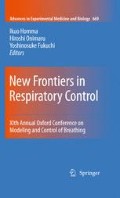Abstract
Breathing is primarily involuntary and generated for metabolic and homeostatic purposes in the brainstem. However, changes in breathing can be voluntary or altered by various environmental stimuli. Therefore, breathing is categorized as either metabolic or behavioral. Breathing that changes during various emotions is a subcategory of behavioral breathing due to the strong connection it has with emotion and behavior. The limbic system, located in the medio-temporal lobe of the brain, is the center that governs emotion.
Access this chapter
Tax calculation will be finalised at checkout
Purchases are for personal use only
References
Homma, I., Masaoka, Y., and Umewaka, N. (2006) Breathing mind in Noh. In I. Homma and S. Shioda (Eds.), Breathing, feeding and neuroprotection (pp. 125–134). Tokyo: Springer-Verlag.
Homma, I. and Masaoka, Y. (2008) Breathing rhythms and emotions. Exp. Physiol. 3(9), 11–21.
Masaoka, Y. and Homma, I. (1997) Expiratory time determined by individual anxiety levels in humans. J. Appl. Physiol. 86(4), 1329–1336.
Masaoka, Y. and Homma, I. (2000) The source generator of respiratory-related anxiety potential in the human brain. Neurosci. Lett. 283, 21–24.
Masaoka, Y. and Homma, I. (2001) The effect of anticipatory anxiety on breathing and metabolism in humans. Respir. Physiol. 128, 171–177.
Masaoka, Y. and Homma, I. (2004) Amygdala and emotional breathing. In J. Champagnat (Eds.), Post-genomic perspectives in modeling and control of breathing (pp. 9–14). New York: Kluwer Academic/Plenum Publishers.
Onimaru, H. and Homma, I. (2007) Spontaneous oscillatory burst activity in the piriform-amygdala region and its relation to in vitro respiratory activity in newborn rats. Neuroscience 144, 387–394.
Author information
Authors and Affiliations
Corresponding author
Editor information
Editors and Affiliations
Rights and permissions
Copyright information
© 2010 Springer Science+Business Media, LLC
About this paper
Cite this paper
Homma, I. (2010). Breathing and Noh: Emotional Breathing. In: Homma, I., Onimaru, H., Fukuchi, Y. (eds) New Frontiers in Respiratory Control. Advances in Experimental Medicine and Biology, vol 669. Springer, New York, NY. https://doi.org/10.1007/978-1-4419-5692-7_69
Download citation
DOI: https://doi.org/10.1007/978-1-4419-5692-7_69
Published:
Publisher Name: Springer, New York, NY
Print ISBN: 978-1-4419-5691-0
Online ISBN: 978-1-4419-5692-7
eBook Packages: Biomedical and Life SciencesBiomedical and Life Sciences (R0)

